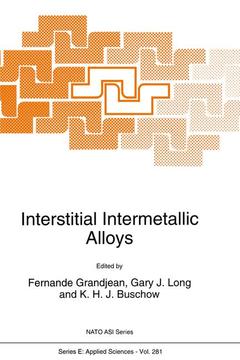Description
Interstitial Intermetallic Alloys, Softcover reprint of the original 1st ed. 1995
NATO Science Series E: Series, Vol. 281
Coordinators: Grandjean F., Long G.J, Buschow K.H.J
Language: English
Subject for Interstitial Intermetallic Alloys:
Publication date: 11-2012
728 p. · 16x24 cm · Paperback
728 p. · 16x24 cm · Paperback
Description
/li>Contents
/li>
It is well known that the density of molecular hydrogen can be increased by compression and/or cooling, the ultimate limit in density being that of liquid hydrogen. It is less well known that hydrogen densities of twice that of liquid hydrogen can be obtained by intercalating hydrogen gas into metals. The explanation of this unusual paradox is that the absorption of molecular hydrogen, which in TiFe and LaNis is reversible and occurs at ambient temperature and pressure, involves the formation of hydrogen atoms at the surface of a metal. The adsorbed hydrogen atom then donates its electron to the metal conduction band and migrates into the metal as the much smaller proton. These protons are easily accomodated in interstitial sites in the metal lattice, and the resulting metal hydrides can be thought of as compounds formed by the reaction of hydrogen with metals, alloys, and intermetallic compounds. The practical applications of metal hydrides span a wide range of technologies, a range which may be subdivided on the basis of the hydride property on which the application is based. The capacity of the metal hydrides for hydrogen absorption is the basis for batteries as well as for hydrogen storage, gettering, and purification. The temperature-pressure characteristics of metal hydrides are the basis for hydrogen compressors, sensors, and actuators. The latent heat of the hydride formation is the basis for heat storage, heat pumps, and refrigerators.
1. An Introduction to the Formation of Interstitial Alloys through Gas-Solid Reactions..- 2. Fundamental Concepts and Units in Magnetism and Thermodynamics..- 3. Matter and Magnetism: the Origin of the Problem..- 4. Thermodynamics of Metal-Gas Reactions..- 5. A Survey of Binary and Ternary Metal Hydride Systems..- 6. Progress in Metal-Hydride Technology..- 7. Rechargeable Nickel-Metalhydride Batteries: A Successful New Concept..- 8. Introduction to Lattice Dynamics..- 9. An Introduction to Neutron Scattering..- 10. Statics and Dynamics of Hydrogen in Metals..- 11. Fundamentals of Nuclear Magnetic Resonance..- 12. Diffusion of Hydrogen in Metals..- 13. An Introduction to the Study of Hydrogen Motion in Metals by Nuclear Magnetic Resonance..- 14. Diffusion of Hydrogen in Amorphous and Nanocrystalline Alloys..- 15. Introduction to Hard Magnetic Materials..- 16. Production of Nitrides and Carbides by Gas-Phase Interstitial Modification..- 17. Electronic Structure and Properties of Permanent-Magnet Materials..- 18. Applications of Neutron Scattering to Interstitial Alloys..- 19. Mössbauer Spectroscopic Studies of Interstitial Intermetallic Compounds..- 20. NMR Studies of Intermetallics and Interstitial Solutions Containing H, C, and N..- 21. Structural Changes of Fe2Ce Alloys by Hydrogen Absorption..- 22. Magnetic Properties of the Rare-Earth Transition-Metal Compounds and their Modification by Hydrogenation..- 23. Interstitial Nitrogen, Carbon, and Hydrogen: Modification of Magnetic and Electronic Properties..- 24. Spin-Reorientation Transitions in Intermetallic Compounds with Interstitial Inclusions..- 25. Role of Interstitial Alloys in the Permanent Magnet Industry..- 26. Characterization and Manufacturing of Permanent Magnets..- 27. Processing and Micromagnetism ofInterstitial Permanent Magnets..- Appendix List of Participants.- Author Index.
© 2024 LAVOISIER S.A.S.




